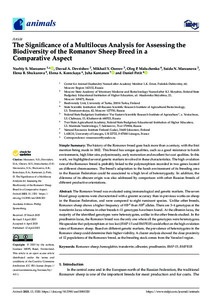The Significance of a Multilocus Analysis for Assessing the Biodiversity of the Romanov Sheep Breed in a Comparative Aspect
Marzanov Nurbiy S; Devrishov Davud A; Ozerov Mikhail Y; Maluchenko Oleg P; Marzanova Saida N; Shukurova Elena B; Koreckaya Elena A; Kantanen Juha; Petit Daniel
The Significance of a Multilocus Analysis for Assessing the Biodiversity of the Romanov Sheep Breed in a Comparative Aspect
Marzanov Nurbiy S
Devrishov Davud A
Ozerov Mikhail Y
Maluchenko Oleg P
Marzanova Saida N
Shukurova Elena B
Koreckaya Elena A
Kantanen Juha
Petit Daniel
MDPI
Julkaisun pysyvä osoite on:
https://urn.fi/URN:NBN:fi-fe2023051744749
https://urn.fi/URN:NBN:fi-fe2023051744749
Tiivistelmä
The Romanov breed was evaluated using immunological and genetic markers. The seven blood group systems were characterized with a greater accuracy than in previous works on sheep in the Russian Federation, and were compared to eight ruminant species. Unlike other breeds, Romanov sheep shows a higher frequency of HBA than HBB alleles. There are 3-4 genotypes at the transferrin locus whereas in other breeds 6-11 genotypes have been found. At the albumin locus, the majority of the identified genotypes were heterozygotes, unlike in the other breeds studied. In the prealbumin locus, the Romanov breed was the only one where all the genotypes were heterozygous. We speculate that polymorphism at two loci (BMP-15 and BMPR1B) could effect on the high ovulation rates of Romanov sheep. Based on different genetic markers, the prevalence of heterozygotes in the Romanov sheep could determine their higher viability. A cluster analysis showed the close proximity of 12 populations of the Romanov breed, as the breeding stock come from the Yaroslavl region.
Kokoelmat
- Rinnakkaistallenteet [27094]
